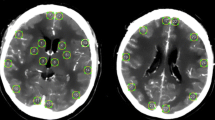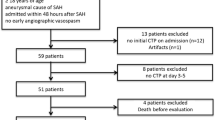Abstract
Purpose
Delayed cerebral ischemia (DCI) still remains a major complication after subarachnoid hemorrhage (SAH). The aim of our study was to evaluate whether flow analysis of admission digital subtraction angiography (DSA) using parametric color coding (PCC), a postprocessing algorithm, allows ultra-early identification of SAH patients at risk for developing subsequent symptomatic vasospasm.
Methods
In this study 52 patients who suffered SAH from aneurysm rupture, were retrospectively enrolled. Of the patients 26 developed DCI and angiographically proven cerebral vasospasm and 26 age, gender-and clinical status-matched SAH patients without DCI served as controls. Using PCC, the following flow parameters were calculated: cerebral circulation time (CirT), cortical relative time to peak (rTTP) and microvascular transit time (TT).
Results
Mean cerebral CirT and cortical rTTP were longer in the DCI group (6.42 s ± 1.54 and 3.16 s ± 0.86, respectively) than in the non-DCI group (5.77 s ± 1.86 and 3.11 s ± 1.41, respectively), but without statistical significance. The mean microvascular TT was statistically significantly (p = 0.04) longer in the DCI group (3.19 s ± 0.78) than in the non-DCI group (2.67 s ± 0.73).
Conclusion
Angiographic flow analysis might be suitable for ultra-early detection and quantitative assessment of microcirculatory injury in SAH patients, predictive of developing subsequent DCI. Prolonged microvascular TT seems to be a significant independent factor positively associated with DCI development. Identifying SAH patients at risk for DCI ultra-early after ictus might contribute to initiate prophylactic therapies before clinical deterioration.




Similar content being viewed by others
References
Molyneux AJ, Kerr RS, Yu LM, Sneade M, Yarnold JA, Sandercock P, International Subarachnoid Aneurysm Trial (ISAT) Collaborative Group. International Subarachnoid Aneurysm Trial (ISAT) of neurosurgical clipping versus endovascular coiling in 2143 patients with ruptured intracranial aneurysms: a randomised comparison of effects on survival, dependency, seizures, rebleeding, subgroups, and aneurysm occlusion. Lancet. 2005;366:809–17.
Lanzino G, Murad MH, d’Urso PI, Rabinstein AA. Coil embolization versus clipping for ruptured intracranial aneurysms: a meta-analysis of prospective controlled published studies. AJNR Am J Neuroradiol. 2013;34:1764–8.
Rosengart AJ, Schultheiss KE, Tolentino J, Macdonald RL. Prognostic factors for outcome in patients with aneurysmal subarachnoid hemorrhage. Stroke. 2007;38:2315–21.
Dorsch NWC, King MT. A review of cerebral vasospasm in aneurysmal subarachnoid haemorrhage: I. Incidence and effects. J Clin Neurosci. 1994;1:19–26.
Longstreth WT Jr, Nelson LM, Koepsell TD, van Belle G. Clinical course of spontaneous subarachnoid hemorrhage: a population-based study in King County, Washington. Neurology. 1993;43:712–8.
Fergusen S, Macdonald RL. Predictors of cerebral infarction in patients with aneurysmal subarachnoid hemorrhage. Neurosurgery. 2007;60(4):658–67.
Frontera JA, Claassen J, Schmidt JM, Wartenberg KE, Temes R, Connolly ES Jr, MacDonald RL, Mayer SA. Prediction of symptomatic vasospasm after subarachnoid hemorrhage: the modified fisher scale. Neurosurgery. 2006;59:21–7.
Weyer GW, Nolan CP, Macdonald RL. Evidence-based cerebral vasospasm management. Neurosurg Focus. 2006;21(3):E8.
Dankbaar JW, de Rooij NK, Rijsdijk M, Velthuis BK, Frijns CJ, Rinkel GJ, van der Schaaf IC. Diagnostic threshold values of cerebral perfusion measured with computed tomography for delayed cerebral ischemia after aneurysmal subarachnoid hemorrhage. Stroke. 2010;41:1927–32.
Aralasmak A, Akyuz M, Ozkaynak C, Sindel T, Tuncer R. CT angiography and perfusion imaging in patients with subarachnoid hemorrhage: correlation of vasospasm to perfusion abnormality. Neuroradiology. 2009;51:85–93.
Sanelli PC, Ugorec I, Johnson CE, Tan J, Segal AZ, Fink M, Heier LA, Tsiouris AJ, Comunale JP, John M, Stieg PE, Zimmerman RD, Mushlin AI. Using quantitative CT perfusion for evaluation of delayed cerebral ischemia following aneurysmal subarachnoid hemorrhage. AJNR Am J Neuroradiol. 2011;32:2047–53.
Malinova V, Dolatowski K, Schramm P, Moerer O, Rohde V, Mielke D. Early whole-brain CT perfusion for detection of patients at risk for delayed cerebral ischemia after subarachnoid hemorrhage. J Neurosurg. 2016;125:128–36.
Strother CM, Bender F, Deuerling-Zheng Y, Royalty K, Pulfer KA, Baumgart J, Zellerhoff M, Aagaard-Kienitz B, Niemann DB, Lindstrom ML. Parametric color coding of digital subtraction angiography. AJNR Am J Neuroradiol. 2010;31:919–24.
Struffert T, Deuerling-Zheng Y, Engelhorn T, Kloska S, Gölitz P, Bozzato A, Kapsreiter M, Strother CM, Doerfler A. Monitoring of ballon test occlusion of the internal carotid artery by parametric color coding and perfusion imaging within the angio suite: first results. Clin Neuroradiol. 2013;23:285–92.
Gölitz P, Struffert T, Lücking H, Rösch J, Knossalla F, Ganslandt O, Deuerling-Zheng Y, Doerfler A. Parametric color coding of digital subtraction angiography in the evaluation of carotid cavernous fistulas. Clin Neuroradiol. 2013;23:113–20.
Greitz T. A radiologic study of the brain circulation by rapid serial angiography of the carotid artery. Acta Radiol Suppl. 1956;140:1–123.
Iwabuchi S, Hayashi M, Yokouchi T, Sato K, Nakayama H, Harashina J, Iwama J, Ishii M, Hiramoto Y, Hirai N, Hirata Y, Saito N, Ito K, Kimura H, Aoki K. Prophylactic intra-arterial administration of fasudil hydrochloride for vasospasm following subarachnoid haemorrhage. Acta Neurochir Suppl. 2015;120:167–9.
Lin CJ, Hung SC, Guo WY, Chang FC, Luo CB, Beilner J, Kowarschik M, Chu WF, Chang CY. Monitoring peri-therapeutic cerebral circulation time: a feasibility study using color-coded quantitative DSA in patients with steno-occlusive arterial disease. AJNR Am J Neuroradiol. 2012;33:1685–90.
Pluta RM, Dejam A, Grimes G, Gladwin MT, Oldfield EH. Nitrite infusions to prevent delayed cerebral vasospasm in a primate model of subarachnoid hemorrhage. JAMA. 2005;293:1477–84.
Iuliano BA, Pluta RM, Jung C, Oldfield EH. Endothelial dysfunction in a primate model of cerebral vasospasm. J Neurosurg. 2004;100:287–94.
Friedrich B, Müller F, Feiler S, Schöller K, Plesnila N. Experimental subarachnoid hemorrhage causes early and long-lasting microarterial constriction and microthrombosis: an in-vivo microscopy study. J Cereb Blood Flow Metab. 2012;32:447–55.
Schubert GA, Seiz M, Hegewald AA, Manville J, Thomé C. Acute hypoperfusion immediately after subarachnoid hemorrhage: a xenon contrast-enhanced CT study. J Neurotrauma. 2009;26:2225–31.
Ohkuma H, Manabe H, Tanaka M, Suzuki S. Impact of cerebral microcirculatory changes on cerebral blood flow during cerebral vasospasm after aneurysmal subarachnoid hemorrhage. Stroke. 2000;31:1621–7.
Etminan N, Beseoglu K, Heiroth HJ, Turowski B, Steiger HJ, Hanggi D. Early perfusion computerized tomography imaging as a radiographic surrogate for delayed cerebral ischemia and functional outcome after subarachnoid hemorrhage. Stroke. 2013;44:1260–6.
Caspers J, Rubbert C, Turowski B, Martens D, Reichelt DC, May R, Aissa J, Hänggi D, Etminan N, Mathys C. Timing of mean transit time maximization is associated with neurological outcome after subarachnoid hemorrhage. Clin Neuroradiol. 2017;27:15–22.
Udoetuk JD, Stiefel MF, Hurst RW, Weigele JB, LeRoux PD. Admission angiographic cerebral circulation time may predict subsequent angiographic vasospasm after aneurysmal subarachnoid hemorrhage. Neurosurgery. 2007;61:1–10.
Author information
Authors and Affiliations
Corresponding author
Ethics declarations
Conflict of interest
P. Gölitz, P. Hoelter, J. Rösch, K. Roessler, F. Knossalla and A. Doerfler declare that they have no competing interests.
Ethical standards
All procedures performed in studies involving human participants were in accordance with the ethical standards of the institutional and national research committee and with the 1964 Helsinki declaration and its later amendments or comparable ethical standards. Informed consent was obtained from all individual participants included in the study.
Rights and permissions
About this article
Cite this article
Gölitz, P., Hoelter, P., Rösch, J. et al. Ultra-early Detection of Microcirculatory Injury as Predictor of Developing Delayed Cerebral Ischemia After Aneurysmal Subarachnoid Hemorrhage. Clin Neuroradiol 28, 501–507 (2018). https://doi.org/10.1007/s00062-017-0616-6
Received:
Accepted:
Published:
Issue Date:
DOI: https://doi.org/10.1007/s00062-017-0616-6




